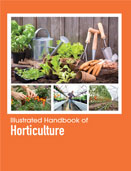Handbooks

Horticulture is an aesthetic science that deals with the important crops which are grown in the gardens e.g. vegetable crops in vegetable garden, fruit crops in fruit orchards. It includes the cultivation of medicinal plants, fruits, vegetables, nuts, seeds, herbs, sprouts, mushrooms, algae, flowers, seaweeds and non-food crops such as grass and ornamental trees and plants. It also includes plant conservation, landscape restoration, landscape and garden design, construction, and maintenance, and arboriculture. Inside agriculture, horticulture contrasts with extensive field farming as well as animal husbandry. Horticulturists apply their knowledge, skills, and technologies used to grow intensively produced plants for human food and non-food uses and for personal or social needs.
Horticulture is the area of agriculture involving the science of growing and caring for plants. Horticulture is socially important because it improves how we use plants, for food and other human purposes, as well as repairing the environment and personal aesthetics.
Horticulture is divided into specializations. The terms used to describe these specializations derive from millennia of common usage and are sometimes at odds with botanical nomenclature. For example, vegetables are described as herbaceous plants of which some portion is eaten raw or cooked during the main part of a meal. Fruits, for horticultural purposes, are described as plants from which a more or less succulent fruit or closely related botanical structure is commonly eaten as a dessert or snack. Production and consumption of high quality fruits and vegetables allows us to maintain a healthy, balanced daily diet. Flowers and ornamental plants enrich our homes and communities, and contribute to our sense of well-being. Horticulture impacts our lives on a daily basis by providing nutritious fruits and vegetables, offering visual enjoyment, and promoting recreational activities.
Illustrated Handbook of Horticulture deals with the study of plant cultivation. It also helps to understand the basic techniques of producing, improving, marketing, and using fruits, vegetables, flowers, and ornamental plants. Horticultural products play a major role in modern society end economy. Fruits and vegetables are part of everyday meals, including special high-value diets for infants and the elderly. Fruits and vegetables are an important component of traditional food, but are also central to healthy diets of modern urban population. They form the basis of a wide array of processed or partially processed products. Increasingly innovative products use fresh fruits and vegetables in fast foods and components of ready meals. Ornamental plants have high cultural values, and urban green is considered an important part of city quality of life. Horticultural production is associated with a high level of management in their production and subsequent use. Horticulture depends on cropping systems that are intensive i.e. require investment, labor and other inputs such as energy and nutrients. They tend to use smaller units of high quality land than other types of agriculture and have generally a high level of innovation. A significant amount of horticulture takes place through protected cultivation where environmental management and precise irrigation in closed circuits are the rule so the environmental impact can be controlled. Inputs such as water, nutrients and chemicals are used highly effectively in protected cropping systems.
The Illustrated Handbook of Horticulture brings to the reader a comprehensive understanding of production, processing and merchandizing of fruits, vegetables, flowers, spices, plantations, medicinal and aromatic plants. The book is suitable for the students and researchers in all areas of environmental horticulture, ornamental horticulture, crop science or other related majors.